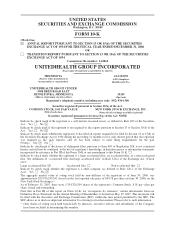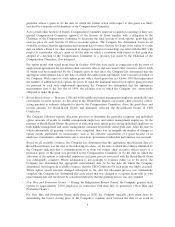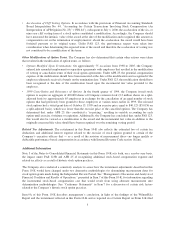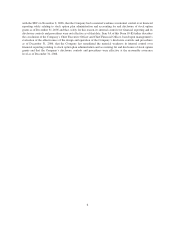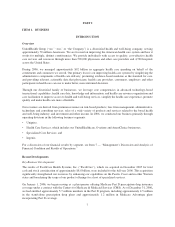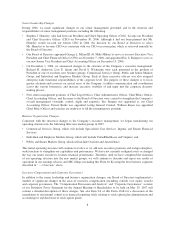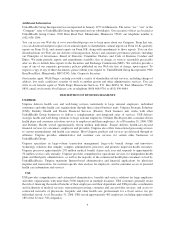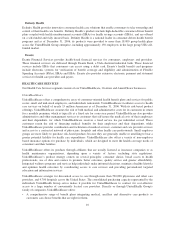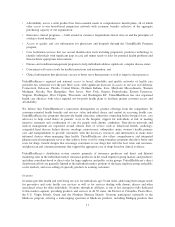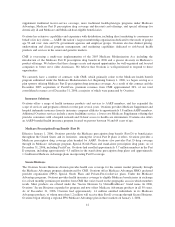United Healthcare 2006 Annual Report Download - page 4
Download and view the complete annual report
Please find page 4 of the 2006 United Healthcare annual report below. You can navigate through the pages in the report by either clicking on the pages listed below, or by using the keyword search tool below to find specific information within the annual report.The Form 8-K also disclosed that certain of the Company’s current and former senior executives had agreed to
increase the exercise price of all stock options granted to that executive with stated grant dates between 1994 and
2002 to eliminate any financial benefit resulting from what the WilmerHale Report concluded was the likely
backdating of grants that they received.
After completing its internal review of the accounting treatment for all option grants, and following consultation
on certain interpretive accounting issues with the Office of the Chief Accountant of the SEC, management has
concluded, and the Audit Committee of the Board has approved the conclusion, that the Company used incorrect
measurement dates and made other errors described below in accounting for stock option grants and, accordingly,
that the Company’s previously issued financial statements should be restated in this Form 10-K.
Summary of the Restatement Adjustments
As of January 1, 2006, the Company adopted Statement of Financial Accounting Standards No. 123 (revised
2004), “Share-Based Payment” (FAS 123R), using the modified retrospective transition method. Under this
method, all prior period financial statements are required to be restated to recognize compensation cost in the
amounts historically disclosed in our consolidated financial statements under Statement of Financial Accounting
Standards No. 123, “Accounting for Stock-Based Compensation” (FAS 123). Prior to January 1, 2006, the
Company accounted for share-based compensation granted under its stock option plans using the recognition and
measurement provisions of Accounting Principles Board Opinion No. 25, “Accounting for Stock Issued to
Employees” (APB 25). Under APB 25, a company was not required to recognize compensation expense for stock
options issued to employees if the exercise price of the stock options was at least equal to the quoted market price
of the company’s common stock on the “measurement date.” APB 25 defined the measurement date as the first
date on which both the number of shares an individual employee was entitled to receive and the option or
purchase price, if any, were known.
The restatement in this Form 10-K principally reflects additional stock-based compensation expense and related
tax effects under both FAS 123R, the Company’s current accounting method, and APB 25, the Company’s
historical accounting method, relating to the Company’s historic stock option practices. The restatement also
reflects certain other accounting adjustments, including adjustments unrelated to historic stock option practices,
which are not material either individually or in the aggregate to the current or prior periods.
The principal components of the restatement are as follows:
Revised Measurement Dates. Based on all available evidence, the Company applied the methodologies described
below to determine the appropriate measurement dates under both FAS 123 and APB 25 for grants in the
following categories: (1) grants of approximately 80 million shares on a split-adjusted basis to Section 16 officers
(“Section 16 Grants”); (2) grants of approximately 260 million shares on a split-adjusted basis to middle
management and senior management employees (“Broad-Based Grants”); and (3) grants of approximately 50
million shares on a split-adjusted basis in connection with the hiring or promotion of employees (“New Hire and
Promotion Grants”). As a result of this analysis, the Company has determined that, in most cases, the stated grant
date was not the correct measurement date.
•Section 16 Grants — Section 16 Grants, generally made to eight to twelve officers, required approval by the
Compensation and Human Resources Committee of the Board (the “Compensation Committee”).
For the majority of Section 16 Grants, Compensation Committee approval was reflected in written actions.
The WilmerHale Report concluded that the written actions were generally executed subsequent to the stated
grant dates. (Under Minnesota corporate law, it is permissible to make a Written Action effective as of a date
other than the date on which the last of the required signers affixes his or her signature, even if that effective
date is before the last signature affixed.) Based on the available evidence, the Company has determined that
the appropriate measurement date for each of these Section 16 Grants is the earlier of (a) the date on which a
Form 4 (or other statement of changes in beneficial ownership) was filed with the SEC with respect to a
2

